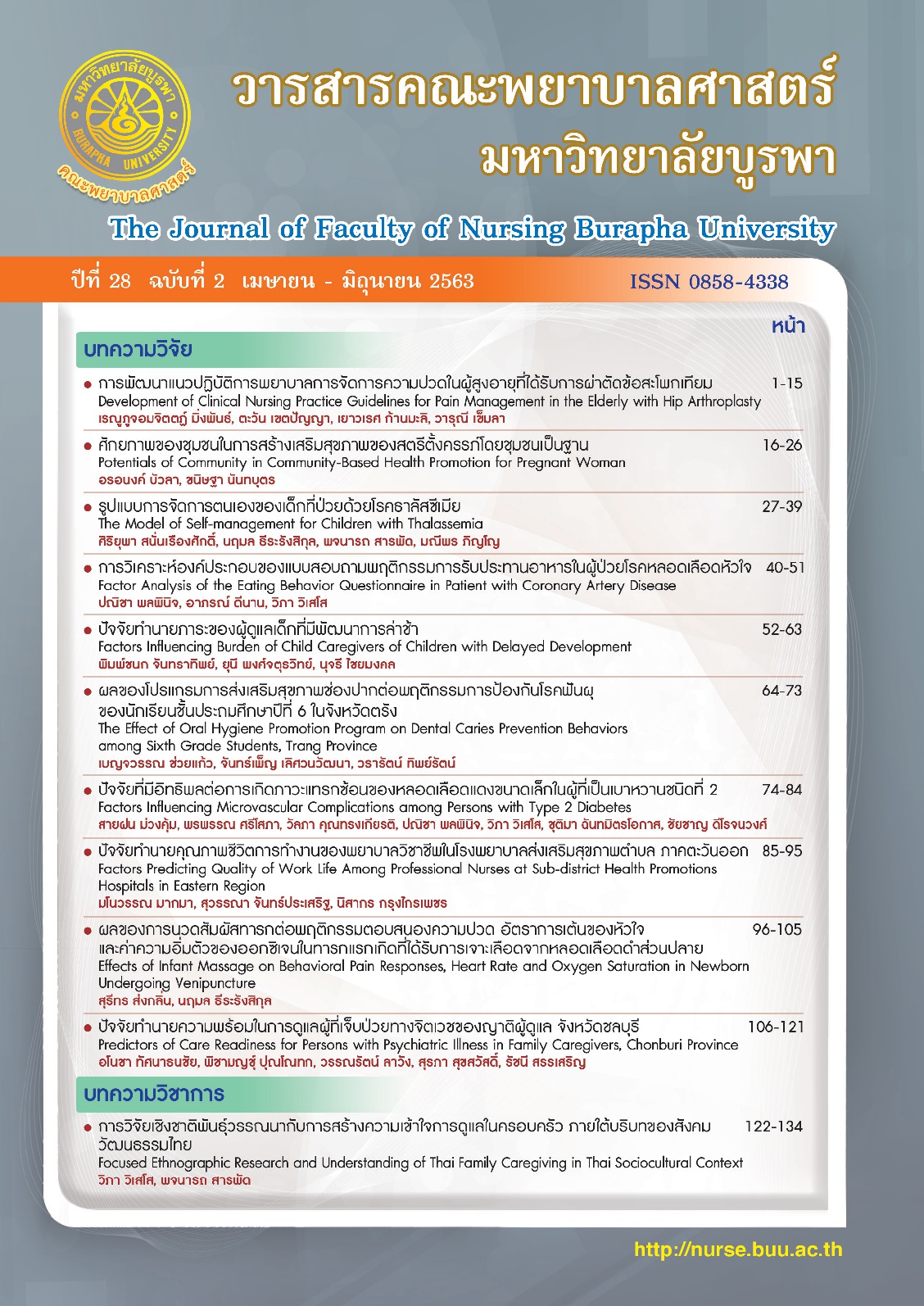รูปแบบการจัดการตนเองของเด็กที่ป่วยด้วยโรคธาลัสซีเมีย
คำสำคัญ:
รูปแบบ, การจัดการตนเอง, เด็ก, โรคธาลัสซีเมียบทคัดย่อ
การศึกษาครั้งนี้มีวัตถุประสงค์เพื่อพัฒนารูปแบบการจัดการตนเองของเด็กที่ป่วยด้วยโรคธาลัสซีเมีย กลุ่มตัวอย่าง
เป็นเด็กที่ป่วยด้วยโรคธาลัสซีเมียที่มารับบริการแผนกผู้ป่วยในและผู้ป่วยนอกของโรงพยาบาลแห่งหนึ่งในภาคตะวันออก
รูปแบบการศึกษาเป็นการวิจัยและพัฒนา แบ่งเป็น 2 ระยะคือ 1) การวิเคราะห์สถานการณ์ เก็บข้อมูลจากการสัมภาษณ์
เชิงลึกกับเด็กโรคธาลัสซีเมียจำนวน 11 คน และการตอบแบบสอบถามความรอบรู้ด้านสุขภาพ ความร่วมมือในการรักษา
พฤติกรรมการจัดการตนเอง ของกลุ่มตัวอย่างจำนวน 88 คน คัดเลือกแบบเฉพาะเจาะจง และ 2) การพัฒนารูปแบบ ได้
จากการวิเคราะห์และสังเคราะห์ข้อมูลจากระยะที่ 1 การวิเคราะห์ข้อมูลโดยใช้สถิติเชิงพรรณา วิเคราะห์ถดถอยเชิงพหุ
แบบขั้นตอน และวิเคราะห์เนื้อหา
ผลการวิจัยในระยะที่ 1 จากข้อมูลเชิงคุณภาพ พบประเด็นหลักในการจัดการตนเองของเด็กคือ การจัดการตนเอง
ด้านชีวิตประจำวัน การจัดการตนเองด้านจิตใจ และสิ่งสนับสนุนการจัดการตนเอง ส่วนข้อมูลเชิงปริมาณพบว่า ความร่วมมือ
ในการรักษา และความรอบรู้ด้านสุขภาพ สามารถร่วมกันทำนายพฤติกรรมการจัดการตนเองของเด็กโรคธาลัสซีเมียได้
ร้อยละ 17.4 ส่วนในระยะที่ 2 ได้รูปแบบการจัดการตนเอง ประกอบด้วย 1) ปัจจัยนำเข้าด้านเด็ก ประกอบด้ยวยมุมมอง
ของเด็กต่อการจัดการตนเอง ความร่วมมือในการรักษา ความรอบรู้ด้านสุขภาพ และพฤติกรรมการจัดการตนเอง ด้าน
บริบทครอบครัวและทีมสุขภาพ 2) กระบวนการ ได้แก่ การเตรียมความพร้อม การพัฒนาความสามารถในการจัดการ
ตนเอง และการสนับสนุนการจัดการตนเอง และ 3) ผลลัพธ์ ได้แก่ ภาวะสุขภาพและคุณภาพชีวิตของเด็ก
ผลการวิจัยครั้งนี้ทำให้ได้รูปแบบการจัดการตนเองของเด็กที่ป่วยด้วยโรคธาลัสซีเมีย เพื่อเป็นแนวทางในการจัด
ทำโปรแกรมการจัดการตนเองของเด็กโรคธาลัสซีเมีย ปัจจัยความสำเร็จที่ทำให้รูปแบบเป็นไปได้จริงและยั่งยืนคือ
ความร่วมมือระหว่างครอบครัวและบุคลากรทีมสุขภาพ
เอกสารอ้างอิง
April, K.T., Feldman, D.E., Zunzunegui, M.V., & Duffy, C.M. (2008). Association between perceived treatment adherence and health-related quality of life in children with juvenile idiopathic arthritis: Perspectives of both parents and children. Patient Prefer Adherence, 2, 121-8.
Ashwill, J.W., & Droske, S.C. (1997). Nursing Care of Children: Principles and Practice. Philadelphia: W.B. Saunders Company. Bloom, B.S., Hastings, J.T., & Madaus, G.F. (1971). Handbook on formative and summative evaluation of student learning. New York: McGraw-Hill.
Cakaloz, B., Cakaloz, I., Polat, A., Inan, M., & Oguzhanoglu, N.K. (2009). Psychopathology in Thalassemia major. Pediatr Int, 51(6),825-8. doi.org/10.1111/j.1442-200X.2009.02865.x
Ceci, A., Baiardi, P., Catapano, M., Felisi, M., Cianciulli, P., De Sanctis, V., . . . & Maggio, A. (2006). Risk factors for death in patients with beta-thalassemia major: results of a case-control study. Haematologica, 91(10),1420-1421.
Cohen, J. (1988). Statistical power analysis for the behavioral sciences (2nd ed.). NJ: Lawrence Erlbaum Associated, Publishers.
Creer, L.T. (2000). Self-management of chronic illness. In M. Boekaert, P.R. Pintrict, & M. Zeidner (Eds.), Handbook of self-regulation (pp. 601-629). California: Academic Press.
Davis, T., Crouch, M., & Long, S. (1991). Rapid estimate of literacy levels of adult primary care patients. Fam Med, 23, 433-435.
DeWalt, D.A., Dilling, M.H., Rosenthal, M.S., & Pignone, M.P. (2007). Low parental literacy is associated with worse asthma care measures in children. Ambul Pediatr, 7(1),25-31.doi:10.1016/j.ambp.2006.10.001
Feldman, D.E., de Civita, M., Dobkin, P.L., Malleson, P., Meshefedjian, G., & Duffy, C.M. (2007). Perceived adherence to prescribed treatment in juvenile idiopathic arthritis over a one-year period. Arthritis Rheum, 57(2), 226-33.
Grey, M., Knafl, K., & McCorkle, R. (2006). A framework for the study of self- and family management of chronic conditions. Nurse Outlook, 54(5), 278-286. doi:10.1016/j.outlook.2006.06.004
Hockenberry, M.J., & Wilson, D. (2015). Wong’s nursing care of infants and children (10th ed.). St. Loius: Missouri.
Imiwat, M. (2012). The effects of the health education program on health behavior development of Thalassemia children. Rajabhat Chiang Mai Research Journal,13(1), 115-128. [In Thai].
Klunklin, P. (2017). Nursing care of children for health promotion. Chiang mai: Smartcoating and Service. [In Thai].
Kuttarasang, R., Sananreangsak, S., & Teerarungsikul,
N. (2017). Effect of family management
promotion program on maternal management
and health status of school-age children
with Thalassemia. Thai Journal of Nursing,
66(3), 1-10. [In Thai].
Lincoln, Y.S., & Guba, E.G. (1985). Naturalistic
inquiry. Newbury Park, CA: Sage Publication,
Inc.
Lorig, K.R. & Holman, H.R. (2003). Self-management
education: History, definition, outcomes,
and mechanisms. Ann Behav Med, 26(1),
1-7.
Medical statistic of Chonburi Hospital (2019). The
report of a medical statistic. Chonburi:
Chonburi Hospital. [In Thai].
Ministry of Public Health. (2018). “Thalassemia”.
Genetic diseases in Thailand (Cited on 2020
Apr 5). Available from https://pr.moph.go.th
/?url=pr/detail/all/02/116500. [In Thai].
Nutbeam, D. (2000). Health literacy as a public
health goal: A challenge for contemporary
health education and communication
strategies into health 21st century. Health
Promotion International, 15(3), 259-267.
Nutbeam, D. (2008). The evolving concept of
health literacy. Soc Sci Med, 67(12), 2072-
2078. doi:10.1016/j.socscimed.2008.09.050
Parker, R.M., Baker, D.W., Williams, M.V., & Nurss,
J.R. (1995). The test of functional health
literacy in adults: A new instrument for
measuring patients’ literacy skills. J Gen
Intern Med, 10(10): 537-41
Perez, M.G., Feldman, L., & Caballero, F. (1999).
Effects of a self-management educational
program for the control of childhood
asthma. Patient Education and Counseling,
36, 47-55.
Pitchalard, K., & Moonpanane, K. (2013).
Improvement of a continuing care model
in child with Thalassemia and caregivers.
Nursing Journal, 40(3), 97-108. [In Thai].
oss, L. A., Frier, B. M., Kelnar, C. J., & Deary, I. J.
(2001). Child and parental mental ability
and glycaemic control in children with Type
1 diabetes. Diabet Med, 18(5), 364-369.
doi:10.1046/j.1464-5491.2001.00468.x
Sananreangsak, S., Lapvongwatanal, P., Virutsetazin,
K., Vatanasomboon, P., & Gaylord, N. (2012).
Predictors of family management behavior
for children with thalassemia. Southeast
Asian J Trop Med Public Health, 43(1),
160-71.
Sanee, A. (2014). Self-management program in
chronic diseases. Journal of The Thai Army
Nurses, 15(2), 129-134. [In Thai].
Viprekasit, V. (2013). Comprehensive management
for Thalassemia. Journal of Hematology
Transfusion Medicine, 23(4), 303-320. [In Thai]
Wattana, C., Srisuphan, W., Pothiban, L., &
Upchurch, S.L. (2007). Effects of a diabetes
self-management program on glycemic
control, coronary heart disease risk, and
quality of life among Thai patients with
type 2 diabetes. Nursing & Health Sciences,
9(2), 135-141. [In Thai].
Wattana, C. (2015). Self-management support:
strategies for promoting disease control.
Journal of Phrapokklao Nursing College,
26(Suppl1), 117-127. [In Thai].
Yusuk, P., Sananreangsak, S., & Teerarungsikul, N.
(2019). Factors related to maternal
management for children with thalassemia.
JOPN, 11(1), 151-62. [in Thai].





